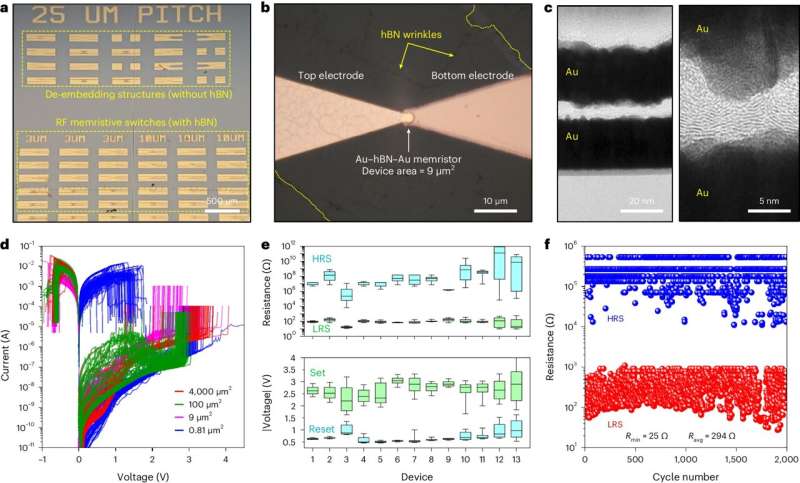
UAB (University of Barcelona) researchers were involved in the development of a switch, an essential device in telecommunications, capable of operating at very high frequency with lower power consumption than conventional technologies. The technology has applications in the new 6G mass communication systems and is more sustainable in terms of energy consumption than current devices. The study was published recently in Nature Electronics.
An indispensable element for controlling signals in electronic communication devices is the switch, whose function is to allow an electrical signal to pass (ON state) or to block it (OFF state). The fastest elements currently used to perform this function are silicon-based (the so-called RF silicon-on-insulator MOSFET switches) and operate using signals with frequencies of tens of gigahertz (GHz). However, they are volatile, i.e., they require a constant power source to maintain the ON state.
To improve current communication systems and meet the demand for increasingly faster communications that will involve the Internet of Things (IoT) and the popularization of virtual reality, it is necessary to increase the frequency of the signals with which these elements are able to act, and improve their performance.
An international collaboration involving researchers from the UAB Department of Telecommunications and Systems Engineering has developed a switch that, for the first time, is capable of performing at twice the operating frequency of current silicon-based devices, with a frequency range of up to 120 GHz, and without the need to apply a constant voltage.
The new switch uses a non-volatile material, called hBN (Hexagonal Boron Nitride), which allows its ON or OFF state to be activated by applying an electrical voltage pulse instead of a constant signal. In this way, the energy savings that can be attained are very significant.
"Our research team from the Department of Telecommunications and Systems Engineering at the UAB was involved in the design of the devices and their experimental characterization in the laboratory," explains researcher Jordi Verdú.
"For the first time we have been able to demonstrate the operation of a switch based on hBN, a non-volatile material, in a frequency range of up to 120 GHz, which suggests the possibility of using this technology in the new 6G mass communications systems, where a very high number of these elements will be required."
For Verdú, this is a "very important contribution, not only from the point of view of device performance, but also towards a much more sustainable technology in terms of energy consumption."
These devices work thanks to the property of memristance, the change in electrical resistance of a material when a voltage is applied. Until now, very fast switches had been developed experimentally from memristors (devices with memristance) created with two-dimensional networks of hexagonal boron nitride (hBN) bonded together to form a surface.
With this arrangement, the device frequency could reach up to 480 GHz, but only for 30 cycles, i.e., with no practical application. The new proposal uses the same material, but arranged in a superposition of layers (between 12 and 18 layers in total) that can operate at 260 GHz and with a sufficiently high stability of about 2000 cycles to be implemented in electronic devices.
More information: Sebastian Pazos et al, Memristive circuits based on multilayer hexagonal boron nitride for millimetre-wave radiofrequency applications, Nature Electronics (2024). DOI: 10.1038/s41928-024-01192-2
Citation: International team creates high-frequency switch for future 6G networks (2024, July 9) retrieved 9 July 2024 from https://techxplore.com/news/2024-07-international-team-high-frequency-future.html
This document is subject to copyright. Apart from any fair dealing for the purpose of private study or research, no part may be reproduced without the written permission. The content is provided for information purposes only.
